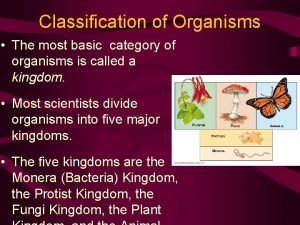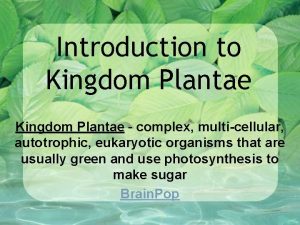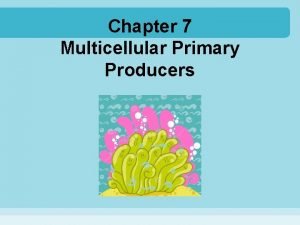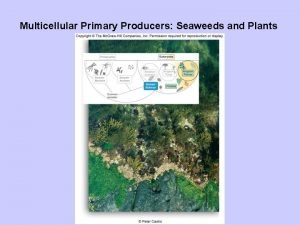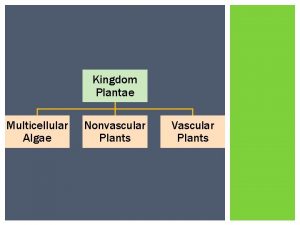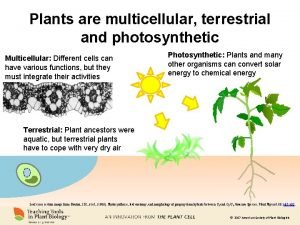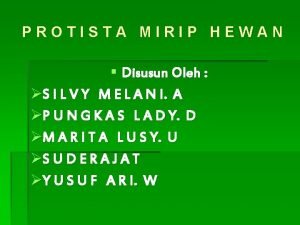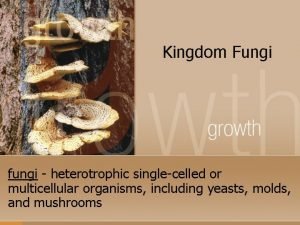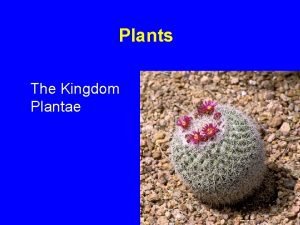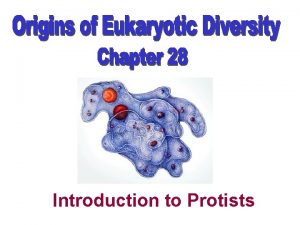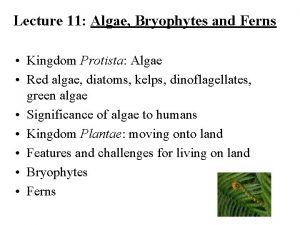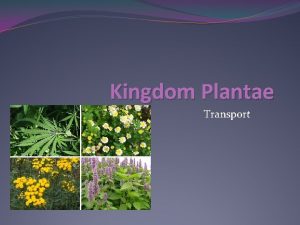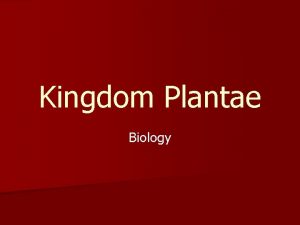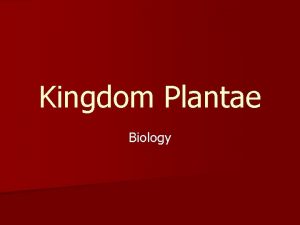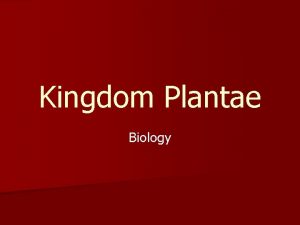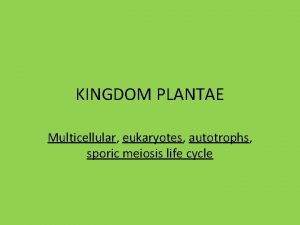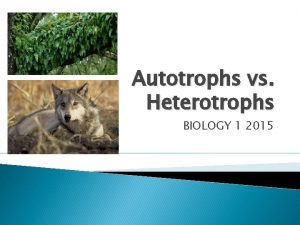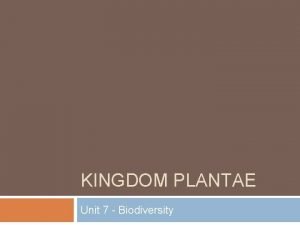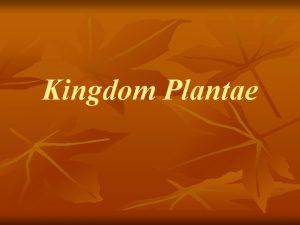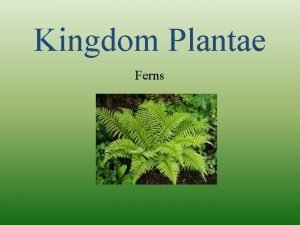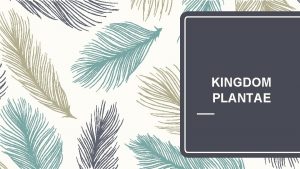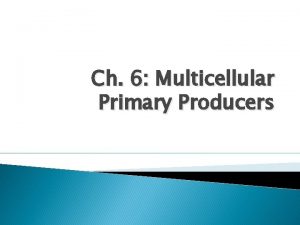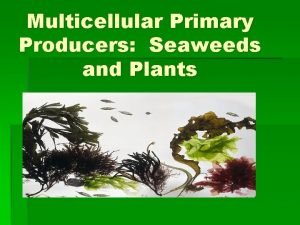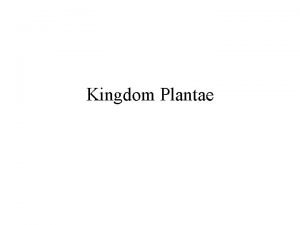Kingdom Plantae 4 Plantae Multicellular Autotrophs or producers























- Slides: 23

Kingdom Plantae

4. Plantae • ________ Multicellular Autotrophs • ________or producers • Cells have _______ Cell _______ Chloroplasts Wall and ________ waxy _____ cuticle to prevent water loss • Have ____ • Colors can be vibrant to attract insects and birds for pollination

Plantae Structure (Fill-in chart) A: Leaf Site of photosynthesis Flat, so it absorbs the most light Waxy surface to prevent water loss

Plantae B: Stem Support for the leaves; used in transport Stores food Ex: celery

Plantae C: Roots Absorbs water and minerals Anchors (holds) plant in soil Some plants store food in roots Ex: potatoes, carrots, turnips

Plantae Photosynthesis: • Process by which green plants use carbon dioxide, water, and light energy from the Sun to produce glucose (food) and oxygen • Occurs in the plant’s ______ leaf Oxygen (O 2) • Provides most of the atmospheric __________ • Equation: Sunlight 6 CO 2 + 6 H 2 O ---- C 6 H 12 O 6 + 6 O 2 Chlorophyll

The diagram shows a green plant carrying on photosynthesis. Identify two things shown in the diagram that the plant needs for photosynthesis to occur. Carbon dioxide (CO 2) ______________ Water (H 2 O) Sun ___________ Identify one product, other than sugar, that results from the process of photosynthesis. Oxygen (O 2) ______

Plantae Making Inferences Oxygen (02) is produced in photosynthesis. In what process do both plant and animals use oxygen to make energy? Cellular Respiration

Plantae Transportation Food from the leaves to the • Phloem - Transports _____ rest of the plant water and _______ dissolved • Xylem - Transports _____ minerals from the roots to the rest of the plant ______

Plantae Transpiration stomata Water loss through the plant’s ______. Process of _____ Stomata: pores in leaves. Video

Plantae Gas Exchange CO 2 enters the stomata & O 2 (along with H 2 O) leave the stomata.

Plantae Putting it all Together Where does water enter the plant? Roots How does water get to the rest of the plant? Xylem Where in the plant are the sun’s rays absorbed? Leaf Where does CO 2 enter and O 2 exit the plant? Stomata How does the sugar made in photosynthesis get to the rest of the plant? Phloem What happens to excess water in the plant? Exits the stomata in the process of transpiration

Plantae • Structures: Pistil - Female _____ part of the flower that produces the Eggs _______ Male part of the flower that produces the Stamen - _______ Pollen grains (male sperm) ________

Label the FLOWER stigma style ovary with ovules sepals stem A flower has both male and female reproductive parts: anther The MALE part is called the STAMEN filament and is made of the anther and filament. The FEMALE part is petal the PISTIL, and is made of the STIGMA, STYLE, and OVARY. The PETALS attract receptacle pollinators.

Plantae Pollination - transfer of _____ pollen from the stamen to ________ the pistil How? Wind, insects, birds, bats, even water Video ________ Fertilization - joining of a sperm and an egg cell; occurs after pollination

Plantae seed Once the egg is fertilized, it develops into a _____and fruit to protect the seeds the ovary develops into a _____ Video 2 Seeds are dispersed (spread) by Wind, water, gravity, and animals _______________________

Label the SEED The embryo is the part that will turn into a plant once the embryo seed germinates. The cotyledon seed coat stores food for the seed until it is ready cotyledon to grow. The seed coat protects the seed.

Plantae Structure protective covering • Seed Coat : _______ • Cotyledon: Stored _______ food • • • Embryo root First Leaves ________ Germination – the development of the seed into a plant • Video

Practice Which sequence represents the order of development for many plants? (A) seed develops inside fruit seed is dispersed seed germinates plant grows (B) seed is dispersed seed develops inside fruit seed germinates plant grows (C) seed germinates plant grows seed is dispersed seed develops inside fruit (D) seed is dispersed plant grows seed germinates seed develops inside fruit Video A

Plantae Identifying Plants cone Conifers- seeds are exposed in a _____ flowering plants, seeds are protected in Angiosperms-______ fruit a ____

Let’s discuss. . . Plants have both male and female parts. Why do you think the male and female parts mature at different times? If they matured at the same time, plants would selfpollinate, decreasing the genetic diversity that would occur if the pollen was transferred to another plant.

Plantae Ecological Succession: Changes in a community that occurs over a _____ long • ______ period of time • Going from a state of grasses to a forest • Example: Burning of the Long Island Pine Barrens • Video 2

 Members of what kingdom are multicellular producers
Members of what kingdom are multicellular producers Plant - multicellular eukaryote of the kingdom plantae
Plant - multicellular eukaryote of the kingdom plantae Are protists eukaryotic
Are protists eukaryotic Plantae kingdom drawing
Plantae kingdom drawing Kingdom of protist
Kingdom of protist Nnn ruled
Nnn ruled Old kingdom middle kingdom new kingdom
Old kingdom middle kingdom new kingdom Capital of egypt during the old kingdom
Capital of egypt during the old kingdom Old kingdom middle kingdom new kingdom
Old kingdom middle kingdom new kingdom Primary producers in kelp forests
Primary producers in kelp forests Group of multicellular oxygen producers
Group of multicellular oxygen producers Is seaweed a primary producer
Is seaweed a primary producer Is algae non vascular
Is algae non vascular Plantae characteristics
Plantae characteristics Is kingdom fungi unicellular or multicellular
Is kingdom fungi unicellular or multicellular Mostly multicellular
Mostly multicellular Terrestrial plant
Terrestrial plant Kingdom protista multicellular unicellular
Kingdom protista multicellular unicellular Are fungi multicellular or unicellular
Are fungi multicellular or unicellular Plantae common characteristics
Plantae common characteristics Kingdom plantae
Kingdom plantae Beneficial algae
Beneficial algae Character of plants
Character of plants How do plantae get nutrients
How do plantae get nutrients
